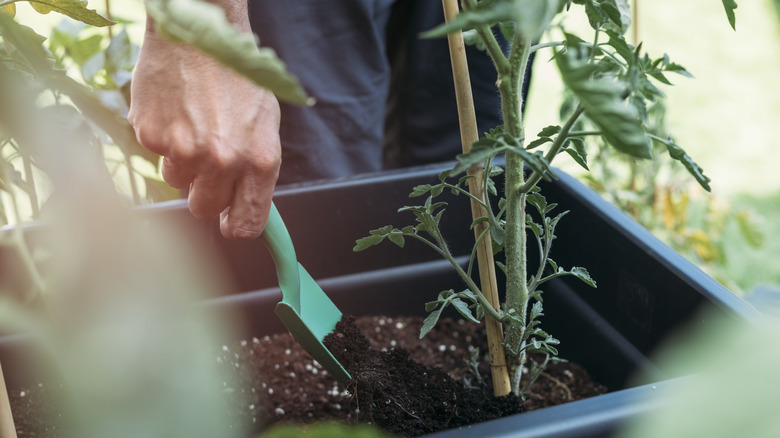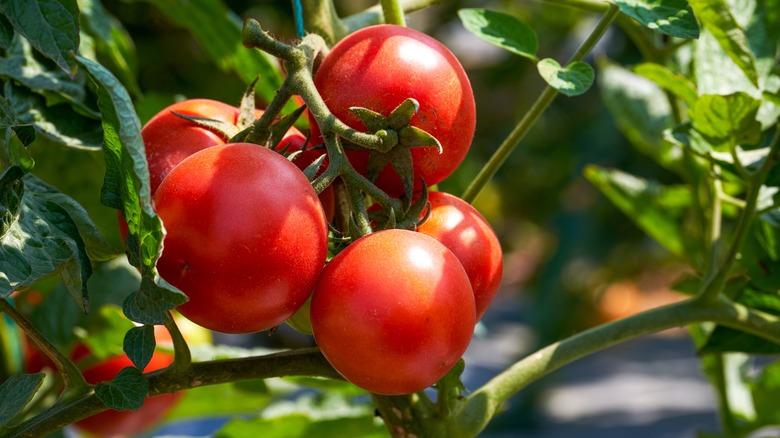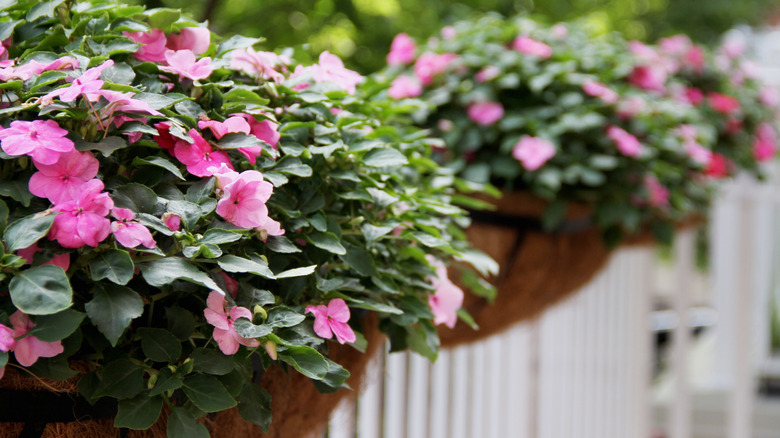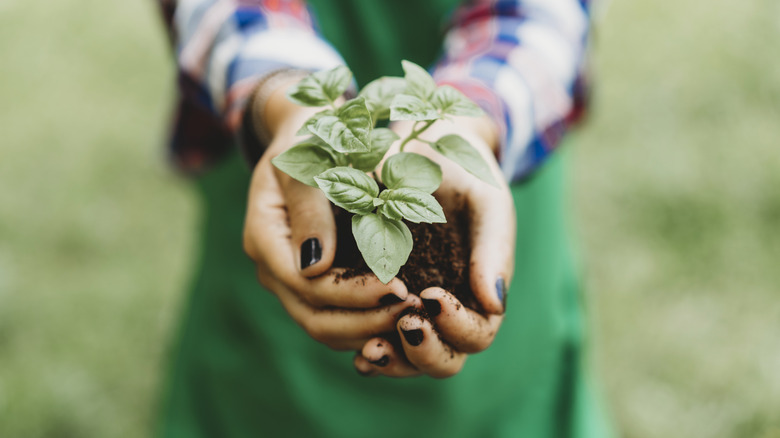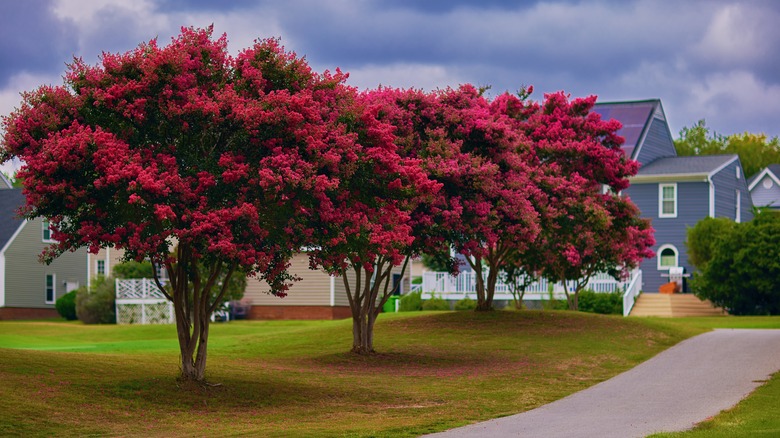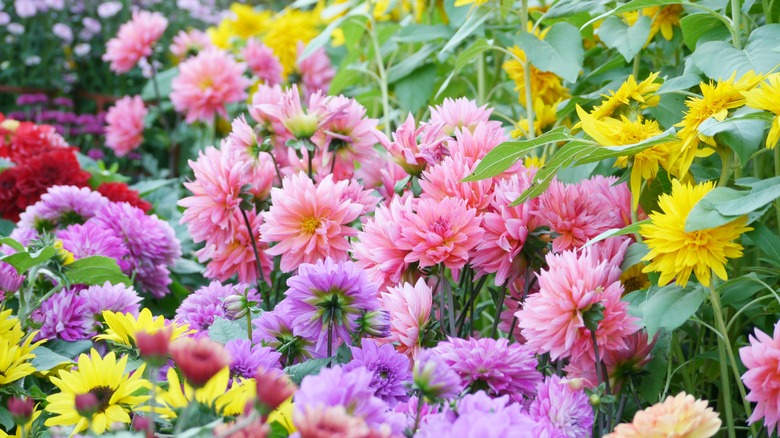Plants That Need Extra Fertilizer In August For Long-Lasting Blooms
We may receive a commission on purchases made from links.
Just like a Fourth of July fireworks display, we want our garden to have a grand finale before it fades away until next year. An infusion of fertilizer in August is just what some plants need for a top end-of-season performance. A burst of extra nutrients at this time is great for late-blooming plants and can strengthen perennials for better blooms in the future. Enjoy sweet tomatoes, vibrant impatiens, bushy basil, and a profusion of chrysanthemums and crape myrtle this year with an extra dash of fertilizer.
Gardening experts rank fertilizing as one of the most crucial late-summer gardening tasks. It's hard to be sure of how much fertilizer you really need in your garden, and not every growing thing on the list will enjoy the same type or quantity. Keep in mind that plants can only process extra nutrients if the soil is moist and don't fertilize flowers that have gone dormant due to drought or high temperatures. Read on to discover why and how these common plants will flourish with a late-season health boost.
Tomatoes
If extra juicy and sweet fruit will be the result, then definitely fortify your tomatoes with fertilizer in August for more blooms. Research has shown that using a bit more than the prescribed amount of nitrogen, phosphorus, and potassium fertilizer (NPK) on tomatoes can result in a significantly higher yield and better quality. These fertilizers may also lead to higher sugar content in the fruit, making for an extra tasty tomato. By the end of summer, soils can run low on nitrogen. Dosing your tomatoes up with this vital nutrient can help stave off early blight and may lead to a better harvest.
The right fertilizer formula is key, and how to apply it is even more important. Water-soluble products like Miracle-Gro are safe and reliable. For some nutrient nitty-gritty, check out some facts about the best fertilizer for healthy tomatoes. If you're using a granular variety, know that too much can kill tomatoes. Sprinkle this type of supplement in a circle around the plant, between 1 and 2 feet from the leaves or stem, and water it in.
Impatiens
Glossy, dark leaves mingling with blooms of pink, magenta, purple, white, and red make impatiens an eye-catching part of a landscape. These plants don't typically need much fertilizer, but not fertilizing them right is an avoidable mistake that will hurt your impatiens. The right kind of late feeding can lead to improved flowering.
It's wise to have a light hand when fertilizing impatiens. They respond well to a small amount of slow-release general-purpose granules applied around the plants. If they are growing under trees, add a little more fertilizer than you'd give to these plants growing in other areas since they share nutrients with hungry tree roots. Potted impatiens can also tolerate a more liberal amount of fertilizer. Take care not to over-fertilize with nitrogen since impatiens will often put the extra nutrients into leaf and stem growth rather than better blooms. Then, spraying their leaves with a foliar fertilizer like Organic Broad Spectrum Plant Spray is a way to direct nutrients to the flowers and prevent legginess.
Basil
Basil smells like late summer to any herb gardener. This is a plant we can't seem to get enough of, and any tips on how to promote better growth are more than welcome. This fragrant herb loves soil amended with compost and extra nutrients. All-purpose soluble fertilizer is a reliable strength booster, but near harvest time, basil is due for a nitrogen fix. When your plants are getting close to harvest time, side-dress them with an all-purpose or organic liquid nitrogen fertilizer like PetraTools liquid nitrogen fertilizer or Dr Earth Nitro Big nitrogen plant food.
The University of Washington shares that you can coax basil plants into two harvests with the help of fish fertilizer. Harvest all of your plant except for at least one node with two or more viable shoots. Mix up a solution of 1 tablespoon of fish fertilizer per half-gallon of water. In a few weeks, you could end up with another small crop.
Crape myrtles
Luscious flowering poufs atop graceful trunks characterize crape myrtles. These stunning trees sport blossoms in deep pink, orchid purple, fiery red, and shades in between. With just the right ratio of fertilizer, this season-long bloomer can keep its stunning show going through the dog days of August.
Apply fertilizer to crape myrtles sparingly in the late season. These trees like 8-8-8, 10-10-10, 12-4-8, or 16-4-8 formulas, and you can add it to the mulch around the tree. The Crape Myrtle Company considers the plant a heavy feeder, and they recommend Miracle-Gro for healthy growth. Apply a pound of fertilizer per inch of the diameter of your tree's trunk, and be sure to include all of the plant's trunks in your calculation. Water your tree immediately after fertilizing, or add the food right before it rains. Despite being a hungry plant, too much fertilizer can actually lead to fewer blossoms on your crape myrtle. If your soil is high in nitrogen, you may not see blooms. In this case, it's wise to do a soil test before adding any more nutrients. Just the right amount of nitrogen is essential.
Chrysanthemums
A favorite with bees and humans alike, chrysanthemums are among the world's most popular flowers. These blooms come in a rainbow of colors that can last through late fall, and an extra serving of fertilizer in August can help the blossoms endure until the frosts arrive.
A high-potassium fertilizer is ideal when you see buds emerging; this element helps flowers develop. Avoid slow-release fertilizers that don't allow you to fine-tune the dosing. High summer temperatures can force these formulas to kick out the nutrients too quickly, and too much fertilizer at one time can damage roots. As for products, Farmer's Secret Fruit & Bloom Booster is a good bet. But banana peels can be used to fertilize your garden with extra potassium, as well. Add this element when you water your mums in the morning, but once you see color on your buds, stop fertilizing to ensure their best color.
